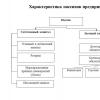Edwards syndrome - causes, symptoms, diagnosis and treatment methods. Edwards syndrome: photos, causes, diagnosis, treatment Edwards syndrome in newborns
(trisomy 18) is the second most common chromosomal disorder after Down syndrome. The incidence of Edwards syndrome is 1:5000-1:7000 newborns. Girls with Edwards syndrome are born three times more often than boys.
| Picture 1. An example of diagnosing Edwards syndrome using QF-PCR. | Figure 2. Sick child with Edwards syndrome. |
| An example of diagnosing Edwards syndrome (trisomy 18). Markers located in the region of chromosome 18, critical for the development of Edwards syndrome, are highlighted in purple. In the genotype of the studied sample, 1 peak is observed for the D18S978 marker (the marker is uninformative), for the D18S535 and D18S386 markers - 3 peaks (trisomy), for the D18S390 and D18S819 markers - a dose effect - an unequal ratio of the heights of the two peaks (trisomy). Thus, trisomy was detected for four markers (D18S535, D18S386, D18S390 and D18S819), which allows us to establish the diagnosis of Edwards syndrome. The genetic sex corresponds to male - there are peaks corresponding to the Y chromosome for the markers Amelogenin, 4SH, ZFXY, TAFL and there is a peak of the SRY gene. |
|
The “gold standard” for detecting chromosomal disorders throughout the world has long been and continues to be the method of karyotyping with differential chromosome staining. This method allows you to analyze the karyotype as a whole and determine large (at least 5-10 million base pairs) chromosomal rearrangements. However, it has a number of limitations, such as labor intensity, duration (1-2 weeks), high requirements for the qualifications and experience of the specialist conducting the study, as well as, in some cases, technical problems (insufficient quantity and quality of the studied material, lack of mitoses or cultural growth).
The method of quantitative fluorescent polymerase chain reaction (QF-PCR), which is increasingly used to diagnose aneuploidies, including Edwards syndrome, does not have these disadvantages (Fig. 1). This method has reliability comparable to that of standard karyotyping, is faster, cheaper, less demanding on the quantity and quality of material (since it is not associated with the growth of a cell culture), and allows simultaneous analysis of a large number of samples. However, the QF-PCR method also has limitations: in mosaic cases, it allows detecting only high-level mosaicism (from 20%), in addition, it cannot exclude the presence of rarer chromosomal disorders that may be associated with fetal malformations. When conducting prenatal diagnosis of Edwards syndrome, in addition to fetal material, it is necessary to provide biological material to the mother in order to exclude the possibility of obtaining a false negative result due to incorrect sampling of fetal material. Analysis of fetal material is completed within three working days.
With Edwards syndrome, there is a pronounced delay in prenatal development, children are born with prenatal malnutrition (average body weight at birth is 2340 g). The external manifestations of Edwards syndrome are varied (Fig. 2). The most typical are delayed psychomotor development, hypoplasia of skeletal muscles and subcutaneous adipose tissue, congenital heart defects, anomalies of the structure of the face and skull (dolichocephaly, microphthalmia, shortening of the palpebral fissures, low position of the ears, micrognathia, sloping chin), multiple deformities of the hands and feet, developmental anomalies of the gastrointestinal tract, genitourinary system and central nervous system (spina bifida, hypoplasia of the corpus callosum and cerebellum). The life expectancy of children is sharply reduced: 90% of them die before the age of one year from complications caused by congenital malformations (asphyxia, pneumonia, intestinal obstruction, cardiovascular failure).
The cause of the development of Edwards syndrome is the tripling of chromosome 18. Trisomy on chromosome 18 is a special case of aneuploidy - the presence in the genome of a set of chromosomes that is different from the standard one for a given species and is not a multiple of it. Trisomy 18 is usually caused by non-disjunction of chromosomes during the formation of the parent's sex cells (eggs and sperm), resulting in the child receiving an extra 18th chromosome from the mother or father. In this case, all cells of the child’s body will bear the anomaly. In the case when chromosome nondisjunction occurs during the division of any embryonic cell, a mosaic version of Edwards syndrome is observed (10% of cases).
The risk of having children with Edwards syndrome, according to various literature data, does not change or increases slightly with increasing age of the pregnant woman.
Prenatal diagnosis of Edwards syndrome includes two stages. At the first stage, at 11-13 weeks of pregnancy, screening is carried out, which is based mainly on biochemical indicators, since in the early stages ultrasound does not detect any gross developmental anomalies in the case of Edwards syndrome, which can only be detected by 20-24 week. Biochemical analysis of the level of certain proteins in the blood of a pregnant woman (free β-subunit of human chorionic hormone (β-hCG) and pregnancy-associated plasma protein-A (PAPP-A)), taking into account her age, allows us to calculate she is at risk of having a sick child. However, these methods do not make it possible to make an accurate diagnosis, and as a result of the screening, a risk group of pregnant women with an increased likelihood of giving birth to a patient with Edwards syndrome is formed. In the second stage, an invasive procedure is performed in the at-risk group to obtain fetal material necessary to accurately determine the status of the fetus. Depending on the stage of pregnancy, this may be a chorionic villus sampling (8-12 weeks), amniocentesis (14-18 weeks) or cordocentesis (after the 20th week). In the obtained fetal tissue samples, the chromosome set is determined.
The Center for Molecular Genetics diagnoses Edwards syndrome (including prenatal) using the QF-PCR method.
Edwards syndrome, or trisomy 18, is a genetic condition in which a child develops three copies of chromosome 18 in each cell of their body, rather than the usual two.
This is a disorder that is caused by an error in cell division known as meiotic disjunction.
When this happens, instead of the normal pair, the extra chromosome leads to a disruption of the normal developmental pattern, and poses a danger to life, even before birth. The error occurs in approximately 1 in every 2,500 pregnancies and 1 in 6,000 live births.

There are three types of Edwards disease. Everyone has a range of possibilities. It is difficult to predict how an extra chromosome will affect an individual child.
Types
Full trisomy 18
The most common type of Edwards syndrome (occurring in approximately 95% of all cases) is complete trisomy. With it, an additional chromosome appears in every cell of the child’s body. This type is not hereditary.
Partial
Partial trisomies are very rare. Occur when only part of an extra chromosome is present. Some partial syndromes may be caused by hereditary factors. Very rarely, part of a chromosome joins another before or after conception. The victims have two copies, plus a “partial” - additional material.
Mosaic
Mosaic trisomy is also very rare. Occurs when an extra chromosome is present in some (but not all) cells of the body. Like complete mosaic, mosaic is not inherited and is a random event that occurs during cell division.
Effect of trisomy 18 on a child
The extra genetic material causes many problems (birth defects) in the growing baby in the womb and after birth. Just like with Down syndrome, problems range from mild to severe.
Each child has their own unique profile of how Trisomy 18 affects their developing body and organs. Common problems:

- Heart defects:
- VSD (Ventricular septal defect): hole between the lower chambers;
- ASD (sciatic atrium defect): hole between the upper chambers;
- Coarctation of the aorta: narrowing of the outlet vessel;
- Kidney problems;
- Part of the intestinal tract is outside the stomach (omphalocele);
- The esophagus does not connect to the stomach (esophageal artesia);
- Excess amniotic fluid (polyhydramniosis);
- Clasped hands;
- A pocket of fluid on the brain (choroid plexus cyst);
- Rocking legs;
- Delayed growth;
- Small jaw (mycrognathia);
- Small head (microcephaly);
- Low-set, unformed ears;
- Strawberry head;
- Severe developmental delays;
- Umbilical or inguinal hernia.
Antenatal diagnosis
Most cases of Edwards syndrome are diagnosed prenatally. Whether the diagnosis is made prenatally or postnatally, the process is the same. A sample of DNA is extracted from the blood, cells and cultured to study the chromosomes, called a karyotype.

Karyotype is a picture of human chromosomes.

To obtain it, chromosomes are isolated, stained and examined under a microscope. Most often done using chromosomes in white blood cells. A visible extra chromosome confirms the diagnosis.
- Cytogenetic studies;
- Chromosomal analysis;
- Echocardiography;
- Ultrasound during pregnancy.
Prenatal diagnosis based on maternal age screening, serum marker screening, or detection of sonographic abnormalities in the second and third trimester.

Prenatal diagnosis leads to the decision to terminate pregnancy in 86% of cases. Knowledge about survival when termination is not an option is important because this knowledge may influence treatment during labor and the neonatal period.
Pregnancies have a high risk of fetal loss and stillbirth. The likelihood of survival to term increases with increasing gestational age: 28% at 12 weeks, 35% at 18 weeks, 41% at 20 weeks. Fetal losses are evenly distributed throughout pregnancy after 24 weeks without clustering at a particular gestational age.
Cases detected by abnormal sonographic findings are more likely to result in miscarriage or stillbirth. Additionally, the rate of miscarriage or stillbirth is higher for boys compared to girls.
A less well characterized condition known as pseudo trisomy 18 syndrome belongs to the akinesis sequence group of diseases.
Natural history, prognosis
The factors underlying survival potential are unknown. The presence of heart defects does not affect long-term survival. Longer survival has been reported for women compared to men.
When a patient has intensive treatment, common causes of death change and survival rate increases.
Ears and hearing
Sometimes structural abnormalities of the ear appear, such as atresia, microtia. Characteristic features of the outer ear: small with a small lobe, the spiral unfolds, sometimes attached to the scalp (cryptotia).
The ear canal is small, making audiology screening difficult. A wide range of middle and inner ear anomalies have been described. Moderate to severe sensory hearing loss may also be present.
Urogenital
There is an increased incidence of urinary tract infections, possibly due to structural defects. Kidney failure is rare.
Neurological
Several structural abnormalities of the central nervous system have been reported in trisomy 18. The most common are cerebellar hypoplasia, agenesis of the corpus callosum, microcyria, hydrocephalus, and myelomineocele, present in approximately 5% of infants.
Functional neurological features include hypotonia in infancy and hypertension in older children. Central apnea and seizures occur in 25-50%, but are usually easily controlled with pharmacological therapy. Central apnea is one of the leading causes of early death.
Development and behavior
In older children with trisomy 18, significant developmental delay is always present, ranging from severe to profound psychomotor and mental retardation. There is no regression, but a stable status with the slow acquisition of some skills.

In most cases, expressive language and independent walking are not achieved, but some older children can use a walker.
Intellectual age is 6-8 months, most have some of the skills of older children, including independent sleep, feeding, imitation, following a simple command, understanding cause and effect.
All children acquire abilities such as family acceptance and proper diligence. Older children can use a walker, understand words and phrases, use multiple words or signs, crawl, follow simple commands, recognize and interact with others, and play independently.
Thus, children with Edwards syndrome, while demonstrating significant development and cognitive disability, have many more abilities than are usually perceived in the stereotype.
Among patients with the mosaic form, the phenotype is extremely variable, and there is no correlation between the percentage of lesions and the severity of mental impairment.
Control and treatment
After discharge from the hospital, follow-up visits for health monitoring should be regular. In long-term survivors, the frequency of visits decreases as they age, depending on specific needs.
Typically, children with trisomy 18 receive usual care. Regarding the administration of immunizations, the weight and general status of the infant and the presence of a seizure disorder should be taken into account.
Table 2 summarizes the clinical and laboratory findings at birth and beyond.
To learn more Burnout - Get Rid of It Before It Kills You
table 2
| Clinical area | Time | Methods |
| Growth, feeding | Constantly | Use growth curves, explore enteral nutrition requirements |
| Psychomotor, cognitive development | Every visit | Developmental delay, early intervention referral, PT/OT |
| Neurological examination | Every visit | Muscle tone abnormalities, seizures, referral to neurologist if necessary |
| Cardiology, echocardiogram | at birth/diagnosis – follow up as needed | Congenital heart defect, pulmonary hypertension |
| Abdominal ultrasound | at birth - | Kidney failure |
| Every 6 months until youth | Wilms tumor, hepatoblastoma | |
| Ophthalmology | At birth/diagnosis | Deformations of the eyes, |
| older children | Photophobia, refractive errors, prescribe sunglasses as needed | |
| Audiology | At birth/diagnosis – follow up as needed | Sensory hearing loss |
| Orthopedic examination | every visit for children over 2 years old | Scoliosis |
| Gastroenterology | if needed | Gastroesophageal reflux, need for enteral nutrition |
| Pulmonology | if it is needed | Recurrent pulmonary infections, central, obstructive apnea |
| Sleep Study | if needed | Central, obstructive apnea |
Growth and feeding
Growth parameters (weight, length, head circumference) should be checked during each examination, often in the first weeks and months of life, as well as on specific growth charts.

Assessing sucking or swallowing problems using radiographic examination is useful when considering the child's ability to protect the airway.
The use of a feeding tube in the neonatal period or placement of a gastrostomy can be considered a guarantee of adequate and safe nutrition.
Gastroesophageal reflux should be considered as a potential factor in feeding difficulties. If necessary, standard medical therapy can be started. If treatment fails, surgery is considered.
Cardiovascular
Cardiac evaluation, including an echocardiogram, should be performed at the time of diagnosis or the neonatal period. Traditionally, heart defects associated with trisomy 18 have been managed conservatively. Since the 1990s, reports of cardiac surgery in this population have been published.

These studies have shown that most people (82-91%) with trisomy 18 survive corrective heart surgery and can be discharged from hospital.
The most common causes of death are infections. This suggests that cardiac surgery is effective in preventing mortality from congenital heart disease.
Surgery should be considered because it can improve life expectancy, facilitate hospital discharge, and improve the quality of life for both the patient and their family.
The severity of cardiac involvement and indications for pharmacological or surgical treatment vary among patients with Edwards syndrome. Therefore, individual assessment taking into account the overall health of the newborn is required to determine optimal treatment.
Respiratory
An examination by a pulmonologist is done if breathing problems become important, especially in an infant.

Since it is difficult to understand the various factors that may play a role: upper airway obstruction, pulmonary hypertension, central apnea.
Diagnosis is no different for people with similar symptoms. A sleep study is useful in determining the severity of apnea problems.
Decisions about home monitoring and oxygen therapy should be made with parents on an individual basis.
In recent years, there has been an increase in therapeutic procedures, including tracheostomy.
Ophthalmic
An ophthalmologic examination is recommended to identify general structural abnormalities and, in older children, decreased visual acuity. If necessary, treatment of eye diseases is usual. For infants with photophobia, sunglasses are prescribed.
Ears and hearing
Musculoskeletal
In children over 2 years of age, a clinical assessment of the spine should be performed at every medical visit, followed by spinal x-rays and evaluation by a specialist if scoliosis is clinically suspected.
Sometimes, in older children, surgery for severe scoliosis should be considered because of subsequent restrictive lung disease.
The decision to treat clubfoot in infants is difficult because only a small percentage of children can walk with assistance or independently.
Urogenital
If kidney abnormalities are detected, monitor for urinary tract infection and kidney failure with periodic blood and urine tests. Treatment for urinary tract infections is no different from treatment for any other child.
Neoplasia
The high incidence of intra-abdominal tumors, especially Wilms tumor and hepatoblastoma, in trisomy 18 in children justifies the recommendation of abdominal screening in these patients.
There is no set time for screening, but it can be started at 6 months of age and repeated every 6 months. It needs to be continued into adolescence because one of the cases of Wilms tumor developed in a 13-year-old girl.
Neurological
Neurological evaluation is recommended for all patients with trisomy. They usually need physical therapy for muscle tone problems. Management of epilepsy is similar to that of other children. Seizures are well controlled with standard pharmacological therapy.

Development and behavior
Whenever monitoring health progress through a standard assessment is mandatory. Early referral to intervention programs and physical therapy is recommended.
General care and ongoing support
A key element in providing effective health oversight for the care of infants and children with Edwards syndrome is a dedicated primary care provider.
In addition, a referral to a palliative care team provides ongoing support and becomes a good resource for the family and physician.
1 ratings, average: 5,00
out of 5)
Edwards syndrome is a form of a rare genetic disorder in which part of a person's 18th chromosome is duplicated. Most children with this pathology die at the stage of embryonic development; this happens in 60% of cases. The prevalence of Edwards syndrome averages 1:3000-1:8000 cases. Inheritance of the syndrome is not traceable, and the randomness of this mutation is only 1%.
Edwards syndrome was named after Dr. John Edward, who described the first cases in 1960 and documented the pattern of symptoms. Edwards syndrome affects more females than males—about 80 percent of those affected are women. Women over thirty years of age have a greater risk of having a child with the syndrome, although the same can happen to women under thirty, but much less frequently. About 12% of children with the syndrome survive to the age when mental development can be assessed; infants who survive are severely handicapped and usually do not live long. Edwards syndrome is associated with a wide range of disorders that consist of more than one hundred and thirty discrete defects related to the brain, heart, craniofacial structure, kidneys, and stomach.
Causes of development of Edwards syndrome.
Each cell in the human body contains twenty-three pairs of chromosomes, which it inherits from its parents. In humans, each sex cell contains the same number of chromosome sets. In women these are eggs (called XX), and in men (called XY) these are sperm. During the division of a fertilized egg, a mutation occurs under the influence of some factors and an additional chromosome appears in the eighteenth pair, which is responsible for the occurrence of Edwards syndrome. Children with the syndrome inherit the wrong number of chromosomes; instead of two copies, they have three copies of chromosomes. This type of mutation is called “trisomy”; the name is also accompanied by the number of the pair in which the mutation occurred; in the case of Edwards syndrome, this is the eighteenth pair.
The variant described above is a “complete trisomy”, i.e. the child has inherited a complete additional copy of an extra chromosome; statistically, 95% of children with Edwards syndrome are like this. “Full trisomy” has almost all the signs of the disease and is very difficult.
There are two more variants of mutations. Two percent of children with Edwards syndrome have a translocation in pair 18, where only part of the extra chromosome is present. Three percent of children with the syndrome have “mosaic trisomy,” this type of mutation is characterized by the presence of an extra chromosome not in all cells of the body.
Symptoms of Edwards syndrome.
Most children born with Edwards syndrome are underweight and have severe developmental delays. Their head is unusually small, and the back of the head is of pronounced size. Their ears are set low and their upper and/or lower jaws have a developmental defect called micrognathia. This is a condition when the shape of the face is distorted and an incorrect bite is formed.

Children often develop cleft palate and cleft lip, conditions where a cleft occurs in the upper palate and lip, respectively.

Formed cleft lip
Children's hands are often clenched into fists and all fingers have a characteristic uneven position.

Children suffer from clubfoot, and the toes on the lower extremities may be webbed or completely fused together.
Very often, patients with the syndrome experience problems with the heart, lungs and diaphragm due to vascular pathology and the development of congenital defects. Heart defects can be of different nature and number: patent ductus arteriosus, ventricular septal defect, patent foramen ovale.
Mutations can cause the development of inguinal and umbilical hernias, abnormalities of the genitourinary system and dysplastic syndrome. The percentage of development of a particular defect:
System damage and defect (sign) - Frequency %
Brain skull and face - 100%
microgenia - 96.8%
low location and/or deformation of the ears - 95.6%
dolichocephaly - 89.8%
high sky - 78%
cleft palate - 15%
microstomia - 71%
Musculoskeletal system - 98.1%
flexor position of the hands - 91.4%
rocking foot - 76.2%
cutaneous syndactyly of the feet - 49.5%
clubfoot - 34.9%
Central nervous system - 20.4%
Cardiovascular system - 90.4%
Digestive organs - 54.9%
Genitourinary system - 33.5%
Children with Edward syndrome tend to have feeding problems. Problems arise due to disruption of the innate reflexes of swallowing and sucking. Poor development of the sucking reflex and uncoordinated swallowing leads to suffocation of the child.
The child may develop gastroesophageal reflux disease. Congenital clefts of the facial skeleton also cause feeding difficulties. They lead to the need to feed the child through a tube or gastrostomy tube. A specialist can show the child's parents how to properly hold their child's head and body. To prevent reflux, the baby's head should be elevated about thirty degrees or more while the baby eats and for an hour or two after eating.
Diagnosis of Edward syndrome
The diagnosis of Edwards syndrome can be made by identifying all of the above external symptoms during physical examination. A more accurate diagnosis can be made by performing a "karyotyping" test, which involves taking samples of the baby's blood to determine the chromosomal makeup.
Due to the large number of developmental defects and the very low survival rate of children with Edwards syndrome, antenatal diagnostic methods have now been developed. One of the first and most accessible techniques that is carried out in all antenatal clinics is fetal ultrasound. An ultrasound scan in the early stages of pregnancy may reveal malformations of the brain and limbs, as well as the presence of an abundant amount of amniotic fluid, which should alert the doctor. Upon receipt of these results, it is necessary to send the pregnant woman for more detailed and targeted observation in a hospital.
In the hospital, all necessary general clinical tests should be performed and more specific tests should be carried out, such as echography, Doppler, examination of serum blood markers: β-subunit of human chorionic gonadotropin (βCG), α-fetoprotein (AFP), estriol (E3), 17-hydroxy progesterone . To assess the degree of risk of having children with chromosomal abnormalities in all observations, a specially developed computer program PRISCA is used, taking into account the woman’s age, serum markers and gestational age. It is also necessary to perform transabdominal amniocentesis followed by cordocentesis. In the amniotic fluid, in the presence of Edwards syndrome, the following will be determined: AFP, 17-OP, E3, and in the fetal blood the karyotype of trisomy 18 chromosome will be determined.
Treatment of Edwards syndrome
The scientific medical community does not currently know a cure for the syndrome. Children with Edwards syndrome are usually born with physical abnormalities, and doctors are faced with a challenge regarding treatment options. Surgery can correct some defects associated with the syndrome, but the invasiveness of the technique does not justify the results in children, whose life expectancy ranges from several days to months.
Treatment today is limited to palliative care (maintaining the morale of those facing a fatal disease). Five to ten percent of babies with Edwards syndrome survive their first year of life.
Problems associated with disorders of the nervous system and muscle tone affect the development of the child’s motor skills, which can lead to scoliosis, muscle atrophy, and strabismus. Surgical treatment in sick children may be limited due to malformations of the cardiovascular system. Children with the syndrome often experience constipation caused by poor abdominal wall tone and atonic intestines. As a result, infants experience discomfort and have difficulty feeding. Special milk formulas, laxatives and drugs from the group of “defoamers” can alleviate these symptoms. Enemas are contraindicated in this situation because they can lead to electrolyte imbalance in the child.
Children with the syndrome are often developmentally delayed; therefore, it is necessary to use specially designed therapy programs to correct delayed physical development.
Another factor for a poor prognosis is the increased risk of developing a Wilms tumor, a type of kidney cancer. Regular ultrasound examination of the abdominal cavity for the presence of this pathology is recommended.
Sick children are at risk of developing various infections and pathological conditions, such as: genitourinary system infections, otitis media, conjunctivitis of various etiologies, sinusitis, sinusitis, pneumonia, sleep apnea, pulmonary hypertension, congenital heart defects and high blood pressure. It is necessary to be prepared in order to effectively carry out treatment and suspect these diseases in time.
Parents whose child has this syndrome need constant monitoring of their health, since timely detection of the disease can prolong the life of their children.
Edward syndrome prognosis
For the most part, the prognosis for this pathology is not favorable. Most children who are born with Edwards syndrome do not survive their first year of life. The average life expectancy for half of children born with this syndrome is less than two months. Ninety to ninety-five percent of these children die before their first birthday. Five to ten percent of children who survive the first year experience severe developmental disabilities.
Children who have lived through their first year require constant monitoring and supervision, and experience serious developmental difficulties. Their verbal communication skills are limited, although they are able to respond to their parents' comfort and have the opportunity to learn to smile, recognize and interact with caregivers and others. They can acquire skills needed for all children, such as independent feeding and head lifting, skills common to healthy children their age.
General practitioner Zhumagaziev E.N.
Edwards syndrome is a disease caused by chromosomal abnormalities, which is accompanied by a whole complex of various abnormalities and developmental disorders. The cause of this disease is trisomy 18, that is, an extra copy of the chromosome is present in the body, which leads to various genetic complications.
The average risk of having a baby with Edwards syndrome is 1:5000, and most newborns with Edwards syndrome die within the first few weeks of life. Less than 10% live one year. Edwards syndrome means profound mental retardation and numerous birth defects affecting both external and internal organs. The most common include heart, brain, kidney defects, as well as cleft lip and/or palate, small head, clubfoot, and small jaw.
The symptoms of this disease were first studied and formulated in 1960 by Dr. John Edwards. He established a relationship between the manifestation of certain symptoms, and also indicated over 130 defects that are observed during this disease. Almost all of these signs of the disease are quite clearly visible, and it is not possible to eliminate them using existing treatment methods. Perhaps such an opportunity will appear in the future, but it is too early to talk about it.
Why does Edwards syndrome occur?
If the diagnosis of Edwards syndrome was made during pregnancy, then the likelihood of miscarriage or stillbirth is extremely high. Edwards syndrome quite often occurs accidentally and, unfortunately, cannot be prevented.
Currently, there are no preventive measures to prevent this chromosomal abnormality, since the exact causes of its development are not clear, but there are some reasons why the risk of fetal disease may be increased. These include:
- unfavorable environmental factors;
- exposure to radiation and toxic chemicals and radiation;
- tobacco and alcohol;
- heredity - a predisposition to certain diseases can be transmitted through generations;
- exposure to certain medications;
- consanguinity of spouses;
- The most significant factor is the age of the expectant mother - starting from the age of 35, the likelihood of Edwards syndrome and some other chromosomal diseases in the fetus increases significantly.
Forms of Edwards syndrome
The consequences of this chromosomal abnormality are largely influenced by the stage of embryonic development at which it occurs. The full form of Edwards syndrome is the most severe, it develops when three chromosomes appeared at a time when there was only one cell. During subsequent division, the extra copies will be passed on to subsequent cells. Accordingly, a disrupted set of chromosomes will be observed in every cell.
Another form of Edwards syndrome is called mosaic, since in this case healthy and mutated cells form a kind of mosaic. It occurs in 10% of cases. In this case, the signs inherent in Edwards syndrome will appear less strongly, but normal development will be difficult. An excess chromosome occurs at the moment when the embryo already has several cells. The distorted genetic set will be contained only in part of the body, and the remaining cells will be healthy. Occasionally, the cells become concentrated in organs that can be removed, in which case the disease can be prevented.
Another option for partial trisomy is a possible translocation. In this case, not only chromosome nondisjunction is observed, but so-called translocation rearrangement is observed, which leads to information redundancy. The genetic sequence on the two chromosomes may be partially swapped. If one of these chromosomes is the 18th, then its genes will move to another site. The translocation form of Edwards syndrome can occur at the stage of gamete maturation or already during the formation of the embryo. During translocation in one cell, in addition to a pair of 18 chromosomes, there is an extra copy of information on another chromosome. In this case, the deviations do not appear to such a significant extent, since the genes located on it are not duplicated.
Researchers of Edwards syndrome have concluded that 80% of cases of the disease are the complete form of trisomy, 10% are mosaic. The remaining cases are represented by translocation forms of the disease and disorders, as a result of which 2 extra chromosomes appear in the karyotype.
How common is Edwards syndrome?
This information has different meanings in different sources: the lower limit can be said to be 1 in 10,000, and the upper limit is 1: 3,300 newborns. Currently, the average value is 1:7000, which is almost 10 times less common than cases of Down syndrome.
In the course of research, it was noted that the likelihood that a newborn will have an extra 18th chromosome increases in proportion to the woman’s age. This also applies to other deviations caused by trisomy. It is worth noting that in Edwards syndrome, the incidence of the disease does not depend as much on the age of the mother as in cases of Down syndrome and Patau syndrome, that is, with trisomy 13 and 21 chromosomes, respectively.
According to statistics, after 45 years the risk increases to 0.7%, that is, the probability that a child will be born with this syndrome increases several times - up to 1:140-150. The average age of spouses is 32.5 years for a woman and 35 years for a man. It is important to remember that the likelihood of occurrence and the likelihood of having a sick child with Edwards syndrome are different concepts. The average risk is 1:7000 in the case of newborns, and during conception it is 1:3000, that is, it increases more than 2 times. The birth of a child with chromosomal abnormalities is possible both at 30 and at 20 years old; this disease can appear in a child of a healthy couple.
Edwards syndrome is an anomaly that has a direct connection with the gender of the child - it is observed much less frequently in boys. According to research results, Edwards syndrome appears 3 times more often in girls than in boys. Some researchers hypothesize that these statistics can be explained by the influence of the X chromosome. There is a possibility that if there is an extra chromosome 18, this combination has a stabilizing effect, and male zygotes with trisomy 18 are “rejected” by the body.
Are test results always accurate?
Despite the fact that during pregnancy there may be some signs that may be characteristic of Edwards syndrome, in fact it does not develop that often. It is very important to remain calm if any individual symptoms or some ambiguities are detected. Quite often, women on various forums share their experiences and test results. The main thing is to listen to the opinion of competent specialists who will conduct detailed research before making a diagnosis.
Based on the results of genetic testing, the syndrome is diagnosed much more accurately than based on the results of ultrasound and blood tests, so there is no need to worry until thorough research is carried out. There are often cases where a blood test shows that hormone levels are not normal during pregnancy, but a healthy baby is born.
If there are any doubts about the results of classical tests, the doctor prescribes additional testing - most often one of the invasive methods. Cases where the results of genetic testing turned out to be incorrect are extremely rare, their accuracy is more than 99%.
Edwards syndrome during pregnancy
The development of a fetus with an excess chromosome 18 proceeds differently than that of a normal embryo. This can affect the gestation period: quite often post-term babies are born with this diagnosis - their gestation period exceeds 42 weeks. As a rule, pregnancy occurs with complications. There are a number of signs by which doctors can assume the presence of a disease in the fetus.
One of the signs that may accompany Edwards syndrome is lack of fetal activity. In particular, the heart rate may be reduced (bradycardia). Polyhydramnios is quite common. Since the size of the placenta in Edwards syndrome usually does not correspond to the terms and is smaller, the woman’s body cannot ensure the normal development of the fetus. However, all these signs cannot be a sufficient basis for the diagnosis.
Quite often there are cases when 1 umbilical artery develops instead of 2, resulting in a lack of oxygen in the embryo - for this reason, many children experience asphyxia at birth. In this case, an abdominal hernia (omphalocele) may occur. Ultrasound diagnostics can detect formations from the choroid plexuses - essentially these are fluid-filled cavities that do not pose a threat. They usually disappear by the 26th week. The situation is complicated by the fact that quite often such formations accompany all sorts of genetically determined diseases. For example, with Edwards syndrome, cysts are found in almost 30% of children. If such formations are detected, the woman is referred to genetic consultation.
Another common phenomenon with Edwards syndrome is lack of weight (on average a little more than 2 kg) and pronounced malnutrition (chronic eating and digestive disorders).
This disease is characterized by high intrauterine mortality - up to 60% of fetuses diagnosed with Edwards syndrome die in the womb.
Prenatal diagnosis
Since Edwards syndrome is a very severe chromosomal disorder, it is very important to promptly diagnose the disease during pregnancy.
The entire future fate of the patient will depend on the correct diagnosis. Diagnosis can and should be done at the prenatal stage in order to take the necessary measures or terminate the pregnancy in a timely manner. There are several ways to perform prenatal diagnosis of the fetus.
Ultrasound examination can reveal indirect signs that only indicate the possibility of a chromosomal abnormality. These include various internal malformations, low fetal weight, large volumes of amniotic fluid and some others.
In order for the diagnostic results to correctly reflect the current condition, it is highly advisable for a woman to undergo a prenatal screening procedure. This diagnostic method is aimed at identifying with maximum accuracy the risk of chromosomal and other abnormalities in the fetus. Such diagnostics are carried out for all women - it makes it possible to identify among them those who belong to a high-risk group. If a threat is detected, the specialist gives a referral for invasive testing, the results of which can confirm or refute suspicions.
Prenatal screening is divided into two stages. The first occurs at 11-13 weeks of pregnancy, during this period a study of biochemical parameters is carried out. At this stage, ultrasound is still difficult to judge the presence of anomalies, and the information obtained about fetal development cannot be considered sufficiently accurate. A final diagnosis is not made; the woman is only placed or not at risk. At this stage, a blood test is performed to determine hormone levels. In the first trimester, screening results are not yet definitive; they only indicate that there is a possibility that the child may have Edwards syndrome. Calculations are made based on the analysis of blood proteins, which are reliable indicators of the condition of the fetus during pregnancy.
These proteins include protein A (PAPP-A), produced in plasma, as well as β-hCG. This is human chorionic gonadotropin (hCG), a protein produced by cells in the membranes of the embryo and then by the placenta. The alpha unit is common to hCG and some other hormones, but their beta subunits are different. For this reason, it is the β-subunit of hCG that is determined in the blood.
The second stage of prenatal screening is to obtain accurate information about the condition of the fetus. For analysis, a tissue sample is taken and subjected to genetic testing. Any method can be used to collect the sample. The most accurate are amniocentesis (taking a sample of amniotic fluid) and cordocentesis (taking a sample of umbilical cord blood).
Based on the test results, one can judge the state of the karyotype. A negative result will mean that no chromosomal abnormalities have been detected, but a positive answer will confirm fears and form the basis for a diagnosis.
Invasive Testing Methods
The most accurate and reliable methods are considered to be invasive methods that require surgical intervention and penetration into the fetal membrane. They differ from each other in terms of the time required for testing samples and the risks to which the fetus is exposed. The optimal method of collecting a sample is determined in accordance with the recommendations of the doctor and largely depends on the development of the fetus and the anatomical features of the woman. When performing invasive procedures, there is a risk of miscarriage and complications. Such procedures are prescribed only when the risk of disease is higher than the risk of complications.
Already in the early stages, chorionic villus sampling (CVS) can be performed - starting from the 8th week. This is the main advantage of CVS, because the sooner the diagnostic results are known, the greater the chances for preventing complications. For analysis, a sample of one of the layers of the placenta membrane, the chorion, is taken from the uterus. Its structure practically coincides with the structure of fetal tissue. Using the analysis, it is possible to diagnose the risk of not only chromosomal and genetic diseases, but also intrauterine infections. The size of the sample should not significantly affect the course of pregnancy.
Another method of collecting a sample, amniocentesis, is suitable for later stages, starting at 14 weeks. Its essence lies in the fact that a probe penetrates the amniotic membranes of the fetus, with the help of which amniotic fluid is collected - it contains fetal cells. Since the degree of penetration in this case is higher, the likelihood of various complications occurring is somewhat greater.
Another invasive method is cordocentesis. It is recommended to do it no earlier than the 20th week. Its essence is to take a sample of the fetal umbilical cord blood. This method is complicated by the fact that the needle must enter the umbilical cord vessel, and inaccuracies are unacceptable. The procedure is as follows: a special puncture needle is inserted through the anterior abdominal wall, with which a small amount of blood is taken - usually about 5 milliliters. The entire process is monitored using an ultrasound machine. This method can be combined with amniocentesis if there are doubts about the test results.
All these procedures are not absolutely painless and 100% safe for the unborn fetus, however, genetic diseases, especially such as Edwards syndrome, can be much more dangerous. For this reason, women are strongly encouraged to get tested.
After the material is taken in one of the three listed ways, it will be sent for testing. Specialists will conduct a thorough chromosomal analysis of the genetic material, after which it will be possible to confirm or refute the diagnosis.
Due to the fact that invasive methods involve penetration into the membranes, the risk of adverse effects on the fetus increases. Errors during these procedures are unacceptable, however, complications may arise. In particular, the appearance of serious diseases and the development of congenital defects is possible.
The situation is complicated by the fact that in some cases, after such invasive procedures, the risk of spontaneous abortion may increase. One way or another, future parents must decide for themselves whether it is worth exposing the fetus to the risk of miscarriage in order to obtain information about its genetic characteristics.
Non-invasive testing methods
Such methods are absolutely safe for the fetus, since they do not require penetration into the fetal membranes, so there is no direct effect on the unborn child. The accuracy of risk determination is no lower than when using invasive methods. For example, karyotyping requires a sample of the mother's blood, since it contains free fetal DNA - specialists extract them, then copy them and analyze them. This method makes it possible to detect the presence of abnormal chromosomal changes with fairly high accuracy.
Postpartum diagnostics
Since Edwards syndrome is characterized by a fairly large number of pronounced abnormalities, it is quite easy to diagnose even by external manifestations. However, this is not enough, and a procedure is required on the basis of which a diagnosis can be made.
Additional research methods can be used, including:
- Ultrasound, since to identify pathologies it is necessary to examine internal organs, including the heart;
- brain imaging, which can reveal abnormalities;
- consultations with pediatric doctors: ophthalmologist, endocrinologist, neurologist, otolaryngologist; It is important to find specialists who have an understanding of this syndrome and have worked with patients who have been diagnosed with this syndrome.
- To find out whether surgical treatment of the disease is possible, consultation with a qualified surgeon is necessary.
To confirm (or refute) the diagnosis, it is important to obtain all the necessary genetic information. It can be obtained using the karyotyping procedure, during which the genetic code is analyzed.
Karyotyping is an analysis of the chromosome set, which consists of analyzing the venous blood of the parents. Once the cells needed for analysis are obtained, they are placed in an incubator and replicated. When a sufficient number of cells are obtained, their division is stopped, they are stained and the study of chromosomes in the cell nucleus begins.
The analysis requires increased attention and some preparatory procedures, so the results become known in about 2 weeks.
How accurate are genetic testing results?
All of the listed genetic testing methods are highly accurate, especially compared to other analysis methods. The accuracy of the result can exceed 90%, while the probability of a false answer remains quite low.
In the case of a mosaic form, the likelihood of detecting the disease will be lower, since it is impossible to track which cells get into the test material. This is what is most difficult in determining results. So, if only healthy cells were taken for analysis, then it will be impossible to detect the mosaic form. And vice versa: the sample may contain cells with a disrupted chromosomal composition. Then there will be reasons for a positive answer, but the information will not be complete enough.
In any case, it will be better to check the data obtained using other methods - starting with ultrasound and ending with immediate postpartum examination.
It is very important that parents understand: if a genetic abnormality is discovered in a child as a result of testing, it will remain with him for life. Cells cannot change their karyotype, and there are no such forecasts for the near future.
How long do children with Edwards syndrome live?
Disorders caused by trisomy 18 are much more serious than those caused by trisomy 21 (i.e. Down syndrome). People with Down syndrome can live for decades, and they adapt to social life to some extent.
The life expectancy of a child with Edwards syndrome is extremely short: most children do not live to be one year old; only 10% of children survive to this age. Approximately 50% of patients die within the first 2 months, and there is an association with gender. Boys with this syndrome live for about 60 days, and girls - about 280 days.
External abnormalities in Edwards syndrome
External and internal manifestations of the disease can vary significantly depending on the developmental characteristics of the fetus. Most often, chromosomal abnormalities appear in the initial stages of embryonic development, so they affect the development of the entire organism. There are several external signs that are highly likely to suggest the presence of Edwards syndrome in newborns.
One of the most characteristic features of this disease is the distorted shape of the cranial bones: the skull is elongated from the crown to the chin, however, the diagnosis of “microcephaly” (reduction in the size of the skull and brain) or “hydrocephalus” (accumulation of fluid in the brain) is often made. The forehead is narrow, and the occipital side is wider and more protruding, while the ears are located lower than with normal development. The jaw bones are deformed - often this leads to a significant reduction in the lower jaw, it becomes narrow and underdeveloped. As a result, the mouth is also small and often triangular due to the shortening of the upper lip. The sky is high, sometimes there is a gap. The neck may be shortened, with a characteristic fold.
The eye slits are narrower and shorter than necessary, the bridge of the nose is widened and depressed - this is especially noticeable given that the nose is usually narrowed, and the bones of the nose may be visually absent. The eyeball is also subject to changes and disorders that lead to cataracts and coloboma, that is, the absence of part of the eye membrane. In addition, there may be other visual impairments.
The ears are low set and deformed, often in a horizontal plane. The ear lobe is often missing, and sometimes the tragus is missing. The external auditory canal is often narrowed and sometimes may be completely absent.
A wide range of disorders affect the skeletal system. First of all, the joints cannot function normally, so the feet and hands cannot flex and extend as they should. In addition, the feet are underdeveloped, because of this their shape changes, they become less mobile. The big toe is shortened, and the second and third are fused, sometimes so much so that flipper-like limbs are sometimes formed. In 80% of cases, the foot is formed with a sagging arch, a protruding heel and a short big toe.
Due to excessive mobility of the hip joint, dislocations often occur.
The number of arches on the pads of the fingers can be 10 times greater than normal, but the fingers do not have a flexion fold. Almost 30% of patients develop transverse grooves and many ridges on their palms.
Among other things, with Edwards syndrome, the shape of the chest is deformed - it expands, and the intercostal spaces decrease, so it becomes shorter and wider.
Internal organs also undergo significant changes. Almost all patients have heart disease. As a rule, it is characterized by insufficient development of valves in the arteries and aortas. In this case, a ventricular septal defect often appears.
There are very serious disturbances in metabolic processes, such as the functioning of the endocrine system. Due to chromosomal abnormalities, the glands cannot function normally, so growth slows down significantly. Hormonal imbalances lead to underdevelopment of subcutaneous tissue. Every tenth person has a dysfunction of the adrenal glands or thyroid gland.
Decreased muscle tone usually improves over time, and blood circulation improves.
About half of patients have abnormal intestinal development. Most often, this anomaly lies in its unusual location, in which a pouch appears formed from layers of the intestinal wall, and the esophagus narrows too sharply. The kidneys are often segmented or have an irregular arch shape, and there may also be duplication of the ureters.
Changes also affect the genitals. In boys, the testicle may not descend into the scrotum (cryptorchidism) and the structure of the penis changes. In girls, a hypertrophied clitoris is formed, and the ovaries are underdeveloped.
In general, the picture of external and internal abnormalities in Edwards syndrome is as follows. In 100% of cases, abnormalities in the structure of the skull and changes in the shape of the face are observed. Almost 97% have a reduction in the jaw (microgenia), and in just over 95% of cases the structure and location of the ears are disrupted. An elongated skull is observed in almost 90% of patients, a high palate in 78%, and a reduced mouth in 71% of cases.
As for limb disorders, 98% of patients have them. The most common changes in the shape of the hands (more than 91%) and feet (76%).
The development of the cardiovascular system is impaired in more than 90% of patients. About 1/3 of patients have disorders of the genitourinary system, and 55% have disorders of the digestive system.
Feeding infants with Edwards syndrome
Since developmental anomalies are specific and quite serious, feeding children with Edwards syndrome is very difficult. The most serious problems are caused by the absence or impairment of the sucking and swallowing reflex. The child either cannot drink milk or may choke when swallowing.
Deviations in mental development
All patients have an underdeveloped brain, especially the corpus callosum and cerebellum. This inevitably leads to disturbances in mental development. If the child survives, then over time a noticeable lag from peers is revealed.
As a rule, with the full form of Edwards syndrome, oligophrenia develops to a complicated degree. In the mosaic form of the disease, it may not appear so clearly. Often, patients develop convulsive syndrome (brain dysfunction accompanied by involuntary muscle contractions).
The consequences of the mosaic form of the syndrome are not so severe, but the disorders are still numerous and noticeable. Moreover, the severity of the disease does not depend on the ratio of healthy and mutated cells. Another difficulty lies in the diversity of forms of the disease.
The life activity of a child with Edwards syndrome requires increased attention and control. The development of mental abilities occurs with complications, and difficulties in communication are observed. More often than not, they are able to recognize and respond to comfort, and they can learn to smile. If a child learns to recognize certain people, then in some cases very limited communication is possible. With the right care, your baby can learn to lift his head and eat on his own.
Can Edwards syndrome be cured?
The situation is complicated by the fact that Edwards syndrome occurs as a result of genetic disorders that can affect the body's cells to varying degrees. It turns out that for a complete cure, you need to “correct” the material in all diseased cells. At the moment, scientific discoveries do not allow such a procedure, so genetic diseases are still incurable. Experts do not exclude that such a possibility will appear in the future. At the moment, we can only smooth out the consequences of pathological changes.
Since the disease cannot be completely cured, therapy is usually limited to supportive measures. In particular, doctors try to strengthen the morale of the patient and his family as much as possible. Even if the measures taken are as effective as possible, the chances that the child will survive at least one year do not exceed 5-10%. Children who survive have a large number of various deviations and disorders.
The development of children diagnosed with Edwards syndrome at birth is always characterized by the presence of some anomalies. The biggest difficulty for a doctor is to determine the form of the disease and select therapy. External changes can be corrected through surgery, but due to early mortality such measures will most often be unjustified.
External disorders could be corrected through surgery, but the risks increase, since disruptions in the cardiovascular system lead to complications. Serious disorders of the nervous and muscular systems are the reason that the musculoskeletal system cannot develop normally - this leads to scoliosis, strabismus and even muscle atrophy.
Patients with Edwards syndrome have low peritoneal wall tone and intestinal atony; together with the distortion of the facial bones, all this makes breastfeeding very difficult. Some improvements may occur with special milk formulas, foam eliminators and laxatives.
Patients with Edwards syndrome are at risk of developing kidney cancer and should be screened regularly with ultrasound. Complications may arise due to improper functioning of the genitourinary system. There is a high probability of otitis media, sinusitis, conjunctivitis, pneumonia and a number of other diseases.
Since with such a diagnosis quite a lot of malfunctions in the body’s functioning appear, it is important to constantly monitor the patient’s condition in order to notice them in a timely manner and begin treatment.
Is Edwards syndrome inherited?
Edwards syndrome is accompanied by a large number of serious developmental abnormalities, so the question arises whether this disease and the tendency to it are inherited? The answer lies in the cause of the disease itself.
The development of numerous anomalies is the result of the appearance of extra chromosomes: the 18th chromosome is formed either in the germ cell or during the development of the embryo. This means that the parents themselves are healthy, and there are no prerequisites for the development of Edwards syndrome in their genetic material.
Another pressing question: is it possible to transmit an altered set of chromosomes to subsequent generations? The answer to this will be negative, but mainly only because most patients do not survive to reproductive age. In addition, the transfer of an extra chromosome is impossible even theoretically, since the genitals are underdeveloped and reproductive abilities are completely undeveloped.
Based on these facts, as well as numerous medical studies, we can confidently conclude that Edwards syndrome will not be inherited.
Could my next child have Edwards syndrome?
If a family has ever had children with Edwards syndrome, then it is quite logical that the spouses will have a question about the recurrence of such an anomaly. Researchers say this phenomenon is unlikely. Such a deviation in itself is quite rare - it occurs in approximately 1% of cases. Moreover, the probability that Edwards syndrome will be diagnosed again during the next pregnancy is about 0.01%.
The risk of mutations in germ cells or embryonic cells may depend on certain aggressive factors. These include alcohol consumption, contact with cigarette smoke, etc. It is important that a woman carefully monitors her health and refrains from the negative influence of factors that can affect the development of the fetus, both directly and indirectly. Not only the pregnancy period is of great importance, but also the period before conception.
Symptom complex of multiple developmental defects caused by chromosomal pathology (trisomy 18 chromosomes) . The population frequency of this syndrome is 14: 100,000 (1.4 per 10,000). More than 70% of patients are female and this is apparently due to their better vitality
Main diagnostic signs: prenatal hypoplasia, multiple developmental anomalies and stigmas of dysembryogenesis, among which, as a rule, are: “overhanging” occiput, anti-Mongoloid eye shape, low-lying deformed auricles, microgenia (small lower jaw), characteristic overlap of fingers, single umbilical artery . During pregnancy, there is poor fetal activity, a small placenta, and an average birth weight of 2340 g.
Cytogenetically, Edwards syndrome is represented mainly by simple trisomy 18, in which an extra chromosome is found in all cells. A clear dependence of the frequency of births of children with this syndrome on the age of the mothers has been established, which is even more pronounced than with trisomy 13 and 21. Much less common than simple trisomy 18 with Edwards syndrome are mosaic forms and, as an exception, translocation forms. Clinically and phenotypically, all these cytogenetic forms are indistinguishable.
The prognosis is always serious: 60% of patients die before the age of 3 months, no more than 10% survive one year of age.
Treatment is ineffective and symptomatic.
Patau syndrome (trisomy 13). Minimum diagnostic signs: microcephaly, polydactyly, cleft lip and palate, trisomy 13.
The population frequency of Patau syndrome is 1: 7800.
Patau syndrome occurs mainly in two cytogenetic variants: in the form of simple trisomy and Robertsonian translocations D/13, they are phenotypically identical. There are also other forms - mosaicism, reciprocal translocations, inversions, ring chromosome 13, etc.
The main diagnostic signs for Patau syndrome: craniofacial dysmorphia (microcephaly, trigonocephaly, hypotelorism, cleft lip and palate, scalp defects, etc.), limb defects (flexed position of the hands, polydactyly, “rocking feet”), abnormalities of the central nervous system (holoprosencephaly , arinencephaly), defects of the cardiovascular system, genital organs.
Prognosis: about 2/3 of patients die in the perinatal period from respiratory disorders, apnea attacks, and seizures. About 1/3 of patients die in the first year of life and only a few survive beyond 3 years of age.
Wolf-Hirschhorn syndrome (4p-)
Minimum diagnostic signs: hypertelorism, prominent bridge of the nose, “Greek helmet sign”, wide or beak-shaped nose, microcephaly, skull asymmetry, low-set deformed auricles with preauricular folds, delayed psychomotor development, deletion of the short arm of chromosome 4.
Cleft lips and palates and small skin hemangiomas in the facial area are often observed. Muscle hypotonia, clubfoot, foot deformity, and flexor position of the hands are noted. Eye abnormalities include strabismus, proptosis, iris coloboma, cataracts, and microphthalmia. In boys, hypospadias and cryptorchidism are noted. Of the internal organs, the heart and kidneys are most often affected.



















